View in other NatureServe Network Field Guides
NatureServe
Montana
Utah
Wyoming
Idaho
Wisconsin
British Columbia
South Carolina
Yukon
California
New York
Weak Groundsel - Senecio debilis
Other Names:
Packera debilis
Native Species
Global Rank:
G4
State Rank:
S3S4
(see State Rank Reason below)
C-value:
8
Agency Status
USFWS:
USFS:
BLM:
External Links
State Rank Reason (see State Rank above)
Senecio debilis is fairly common in wet alkaline meadows in four counties of southwest Montana. More current data on population sizes and distributions is needed before warranting it as a Species of Concern.
- Details on Status Ranking and Review
Population Size
ScoreU - Unknown
Range Extent
ScoreF - 20,000-200,000 sq km (~8,000-80,000 sq mi)
Area of Occupancy
ScoreD - 6-25 4-km2 grid cells
Number of Populations
ScoreC - 21 - 80
Number of Occurrences or Percent Area with Good Viability / Ecological Integrity
ScoreC - Few (4-12) occurrences with excellent or good viability or ecological integrity
Long-term Trend
ScoreU - Unknown
Trends
ScoreU - Unknown
Threats
ScoreU - Unknown
CommentThreats: Unknown/undetermined.
Intrinsic Vulnerability
ScoreC - Not intrinsically vulnerable
General Description
Plants: Perennial with a short, upright to ascending caudex and seldom-branching fibrous roots. Stems 1 to several (Cronquist et al. 1994), erect, 10–50 cm (Lesica 2012). Herbage glabrous or softly woolly when young, by flowering time glabrous or only sparsely arachnoid in leaf axils (Hitchcock et al. 1955).
Leaves: Basal leaves thick and slightly succulent, occasionally on individual short shoots (Cronquist et al. 1994); the blades ovate or obovate, crenate, 1–6 cm in length (Lesica 2012), 1-3 cm in width; margins wavy, small-lobed, or subentire; petiole usually longer than the blade. Cauline leaves few, narrowing progressively up the stem and becoming sessile (Cronquist et al. 1994), deeply pinnately divided into several pairs of rounded lobes (Lesica 2012) with deep, wide sinuses (Cronquist et al. 1994).
Inflorescence & Heads: Inflorescence corymbiform with 3 to 15 heads (Lesica 2012), densely to somewhat openly arranged (Cronquist et al. 1994). Discoid heads bell-shaped; involucres 5–8 mm high; phyllaries 13 or 21, hairless, green (Lesica 2012).
(P. Lesica's contribution adapted from
Lesica et al. 2012. Manual of Montana Vascular Plants. BRIT Press. Fort Worth, TX)
Phenology
Flowers late June to mid-August (FNA 2006).
Diagnostic Characteristics
Senecio debilis and
S. indecorus have similarities. However, the latter has more sharply-pointed leaf lobes and its leaves are not appreciably thick. It also seldom resides in areas of high alkalinity (
Lesica et al. 2012. Manual of Montana Vascular Plants. BRIT Press. Fort Worth, TX)
Species Range
Montana Range
Range Descriptions
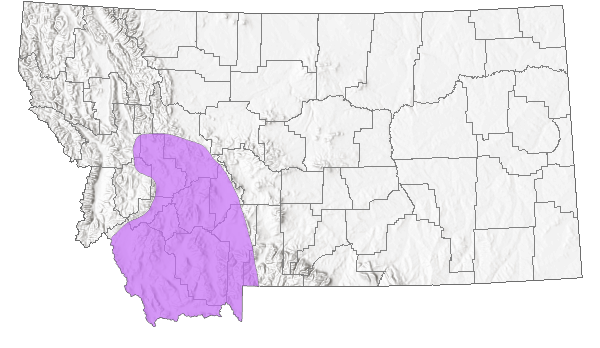
 Native
Native
Range Comments
MT, ID, WY and CO (Lesica et al. 2012. Manual of Montana Vascular Plants. BRIT Press. Fort Worth, TX)
Observations in Montana Natural Heritage Program Database
Number of Observations: 41
(Click on the following maps and charts to see full sized version)
Map Help and Descriptions
Relative Density
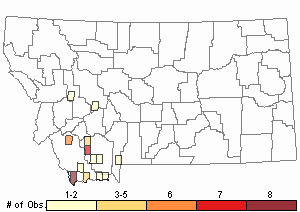
Recency
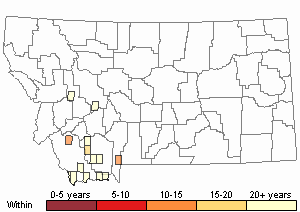

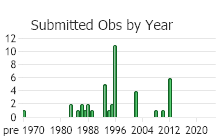
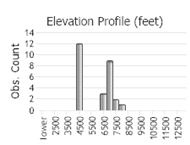 (Observations spanning multiple months or years are excluded from time charts)
(Observations spanning multiple months or years are excluded from time charts)
Habitat
Moist, alkaline meadows in the valley and foothill zones (Cronquist et al. 1994; Lesica 2012).
(
Lesica et al. 2012. Manual of Montana Vascular Plants. BRIT Press. Fort Worth, TX)
Ecology
POLLINATORS The following animal species have been reported as pollinators of this plant species or its genus where their geographic ranges overlap:
Bombus bifarius,
Bombus flavifrons,
Bombus frigidus,
Bombus huntii,
Bombus melanopygus,
Bombus mixtus,
Bombus sylvicola,
Bombus occidentalis,
Bombus insularis,
Bombus suckleyi,
Bombus flavidus, and
Bombus kirbiellus (Schmitt 1980, Thorp et al. 1983, Mayer et al. 2000, Wilson et al. 2010, Pyke et al. 2012, Koch et al. 2012, Williams et al. 2014).
Reproductive Characteristics
Flowers & Fruit: Disk corollas 3–7 mm long (Lesica 2012), orangish (Cronquist et al. 1994); pappus of white capillary bristles. Achenes 1–2 mm long, glabrous (Lesica 2012).
(P. Lesica's contribution adapted from
Lesica et al. 2012. Manual of Montana Vascular Plants. BRIT Press. Fort Worth, TX)
Stewardship Responsibility
References
- Literature Cited AboveLegend:
 View Online Publication
View Online Publication Cronquist, A. 1994. Vol.5, Asteraceae. In: A. Cronquist, N. H. Holmgren, J. Holmgren, J. Reveal, and P. K. Holmgren, eds. Intermountain Flora, Vascular Plants of the Intermountain West, USA. New York Botanical Garden, Bronx, NY.
Cronquist, A. 1994. Vol.5, Asteraceae. In: A. Cronquist, N. H. Holmgren, J. Holmgren, J. Reveal, and P. K. Holmgren, eds. Intermountain Flora, Vascular Plants of the Intermountain West, USA. New York Botanical Garden, Bronx, NY. Flora of North America Editorial Committee. 2006. Flora of North America North of Mexico. Vol. 20. Magnoliophyta: Asteridae, part 7: Asteraceae, part 2. Oxford Univ. Press, New York. xxii + 666 pp.
Flora of North America Editorial Committee. 2006. Flora of North America North of Mexico. Vol. 20. Magnoliophyta: Asteridae, part 7: Asteraceae, part 2. Oxford Univ. Press, New York. xxii + 666 pp. Hitchcock, C.L. 1955. Compositae. In C.L. Hitchcock, A. Cronquist, M. Ownbey, and J.W. Thompson (eds.). Vascular Plants of the Pacific Northwest. Part 5: Compositae. Seattle, WA: University of Washington Press. 343 pp.
Hitchcock, C.L. 1955. Compositae. In C.L. Hitchcock, A. Cronquist, M. Ownbey, and J.W. Thompson (eds.). Vascular Plants of the Pacific Northwest. Part 5: Compositae. Seattle, WA: University of Washington Press. 343 pp. Koch, J., J. Strange, and P. Williams. 2012. Bumble bees of the western United States. Washington, DC: USDA Forest Service, Pollinator Partnership. 143 p.
Koch, J., J. Strange, and P. Williams. 2012. Bumble bees of the western United States. Washington, DC: USDA Forest Service, Pollinator Partnership. 143 p. Lesica, P., M.T. Lavin, and P.F. Stickney. 2012. Manual of Montana Vascular Plants. Fort Worth, TX: BRIT Press. viii + 771 p.
Lesica, P., M.T. Lavin, and P.F. Stickney. 2012. Manual of Montana Vascular Plants. Fort Worth, TX: BRIT Press. viii + 771 p. Mayer, D.F., E.R. Miliczky, B.F. Finnigan, and C.A. Johnson. 2000. The bee fauna (Hymenoptera: Apoidea) of southeastern Washington. Journal of the Entomological Society of British Columbia 97: 25-31.
Mayer, D.F., E.R. Miliczky, B.F. Finnigan, and C.A. Johnson. 2000. The bee fauna (Hymenoptera: Apoidea) of southeastern Washington. Journal of the Entomological Society of British Columbia 97: 25-31. Pyke, G.H., D.W. Inouye, and J.D. Thomson. 2012. Local geographic distributions of bumble bees near Crested Butte, Colorado: competition and community structure revisited. Environmental Entomology 41(6): 1332-1349.
Pyke, G.H., D.W. Inouye, and J.D. Thomson. 2012. Local geographic distributions of bumble bees near Crested Butte, Colorado: competition and community structure revisited. Environmental Entomology 41(6): 1332-1349. Schmitt, J. 1980. Pollinator foraging behavior and gene dispersal in Senecio (Compositae). Evolution 34: 934-943.
Schmitt, J. 1980. Pollinator foraging behavior and gene dispersal in Senecio (Compositae). Evolution 34: 934-943. Thorp, R.W., D.S. Horning, and L.L. Dunning. 1983. Bumble bees and cuckoo bumble bees of California (Hymenoptera: Apidae). Bulletin of the California Insect Survey 23:1-79.
Thorp, R.W., D.S. Horning, and L.L. Dunning. 1983. Bumble bees and cuckoo bumble bees of California (Hymenoptera: Apidae). Bulletin of the California Insect Survey 23:1-79. Williams, P., R. Thorp, L. Richardson, and S. Colla. 2014. Bumble Bees of North America. Princeton, NJ: Princeton University Press. 208 p.
Williams, P., R. Thorp, L. Richardson, and S. Colla. 2014. Bumble Bees of North America. Princeton, NJ: Princeton University Press. 208 p. Wilson, J.S., L.E. Wilson, L.D. Loftis, and T. Griswold. 2010. The montane bee fauna of north central Washington, USA, with floral associations. Western North American Naturalist 70(2): 198-207.
Wilson, J.S., L.E. Wilson, L.D. Loftis, and T. Griswold. 2010. The montane bee fauna of north central Washington, USA, with floral associations. Western North American Naturalist 70(2): 198-207.
- Additional ReferencesLegend:
 View Online Publication
View Online Publication
Do you know of a citation we're missing? Culver, D.R. 1993. Sensitive plant species inventory in the Centennial Valley, Beaverhead County, Montana. Unpublished report to the Butte District, Bureau of Land Management. Montana Natural Heritage Program, Helena, 42 pp. plus appendices.
Culver, D.R. 1993. Sensitive plant species inventory in the Centennial Valley, Beaverhead County, Montana. Unpublished report to the Butte District, Bureau of Land Management. Montana Natural Heritage Program, Helena, 42 pp. plus appendices. Culver, D.R. 1994. Floristic analysis of the Centennial Region, Montana. M.Sc. Thesis. Montana State University, Bozeman. 199 pp.
Culver, D.R. 1994. Floristic analysis of the Centennial Region, Montana. M.Sc. Thesis. Montana State University, Bozeman. 199 pp. Lesica, P. 1990. Vegetation and sensitive plant species of wetlands associated with geothermal areas in the greater Yellowstone ecosystem in Montana. Unpublished report on file at the Montana Field Office, The Nature Conservancy, Helena. 9 pp.
Lesica, P. 1990. Vegetation and sensitive plant species of wetlands associated with geothermal areas in the greater Yellowstone ecosystem in Montana. Unpublished report on file at the Montana Field Office, The Nature Conservancy, Helena. 9 pp. Lesica, P. 1994. The distribution of plant community diversity associated with glacial wetlands in the Ovando Valley, Montana. [Unpublished report.] The Nature Conservancy, Montana Field Office, Helena. 26 pp.
Lesica, P. 1994. The distribution of plant community diversity associated with glacial wetlands in the Ovando Valley, Montana. [Unpublished report.] The Nature Conservancy, Montana Field Office, Helena. 26 pp. Lesica, P., M.T. Lavin, and P.F. Stickney. 2022. Manual of Montana Vascular Plants, Second Edition. Fort Worth, TX: BRIT Press. viii + 779 p.
Lesica, P., M.T. Lavin, and P.F. Stickney. 2022. Manual of Montana Vascular Plants, Second Edition. Fort Worth, TX: BRIT Press. viii + 779 p. Vanderhorst, J.P. and P. Lesica. 1995a. Sensitive plant survey of the Tendoy Mountains in the Beaverhead National Forest, Beaverhead County, Montana. Unpublished report to the Bureau of Land Management, Butte District. Montana Natural Heritage Program, Helena, MT. 59 pp. plus appendices.
Vanderhorst, J.P. and P. Lesica. 1995a. Sensitive plant survey of the Tendoy Mountains in the Beaverhead National Forest, Beaverhead County, Montana. Unpublished report to the Bureau of Land Management, Butte District. Montana Natural Heritage Program, Helena, MT. 59 pp. plus appendices.
- Web Search Engines for Articles on "Weak Groundsel"





